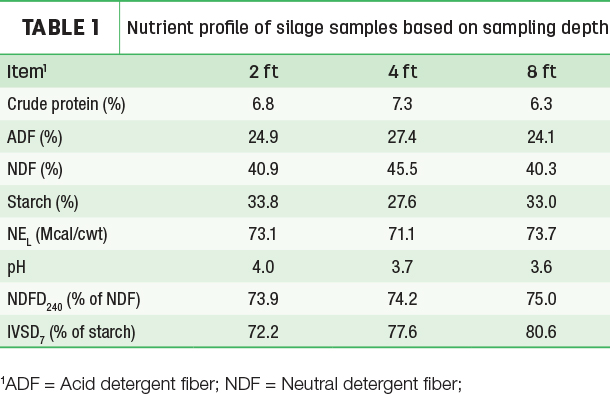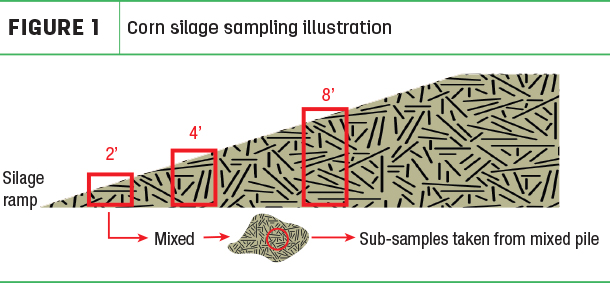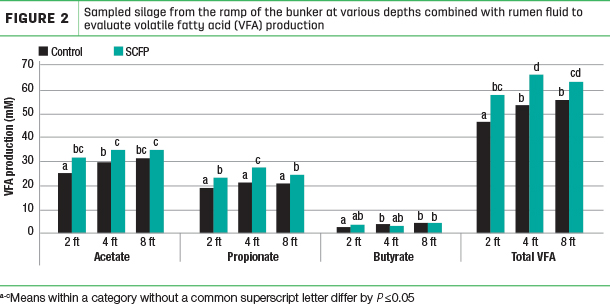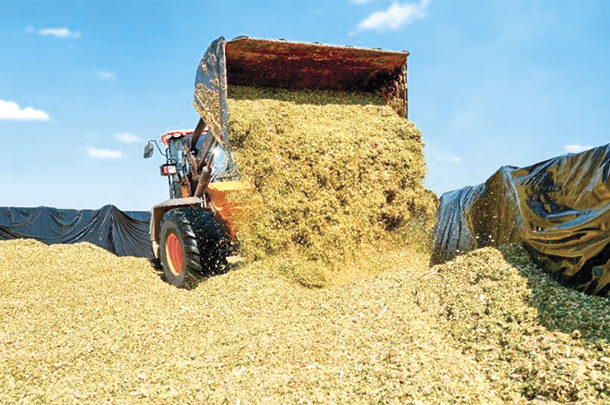Whether it is maximizing production, maintaining herd health, or controlling cost, a key component is the quality of forage fed.
There have been significant technological advances in how producers grow, harvest and store forages to maximize quality. Even with all the advances in silage management, dairies still struggle to maintain production and health when they open a new bunker or pile. To avoid this “new silage slump” when opening a new bunker, it’s important that best practices are considered when harvesting and storing silage.
Harvesting and storing silage
Obtaining and maintaining high-quality corn silage requires good forage management, especially in the areas of harvest, storage and feedout. High-quality corn silage needs to be harvested rapidly, packed well and sealed tightly. Here are some best practices for harvesting and storing silage:
- Proper moisture: One of the most important things to remember when harvesting corn silage is whole-plant moisture level. The desired level of whole-plant moisture will depend on whether the silage is stored in upright or horizontal silos. For bunkers and drive-over piles, the goal for whole-plant moisture is 66% to 68%; for vertical storage structures, the goal is 63% to 66% moisture.
- Monitor chop length and kernel processing: The theoretical length of chop (TLC) should be 3/4 to 1 inch for kernel-processed corn silage. Processed corn silage allows for less sorting of corn cob pucks by cows, which increases the amount of fiber fed. The spacing on the kernel processors should be set at the thickness of a dime (1 millimeter). Processed corn silage allows better digestion of the starch in the corn kernel, which decreases dependence on corn in the total mixed ration (TMR), therefore increasing the level of forage in the TMR from corn silage.
- Proper packing: Bunker silos should be packed constantly while filling. Care should be taken by the blade tractor operator to ensure the layer is being packed as thinly as possible – maximum of 6 inches thick – and that the blade does not disrupt layers already packed. Be sure to build drive-over pile ends, sides and bunker ramps with 800 pounds of tractor packing weight per ton of harvested silage per hour and at a 3-to-12-inch slope. Pack the silage in 4-to-6-inch-thin layers to get the desired silage density to reduce spoilage and increase storage efficiency.
- Make sure the slope is not too steep, as tires will dig into and disrupt packed silage throughout filling. Packing vehicle weight, time per ton, layer thickness, dry matter and particle length are the variables most influencing silage density. Higher silage densities improve dry matter recovery; therefore, have about a percentage point of additional silage available for every pound silage density is increased. For example, increasing silage density from 14 to 18 pounds and along with dry matter per cubic foot will result in 4% more silage to feed. Higher densities will also reduce oxygen infiltration, helping to improve bunk life.
- Covering: After the silage pile is packed, cover as soon as possible, preferably with 6-millimeter plastic. Use a secondary oxygen barrier and secure with either a cover or tires. Many dairies use a second layer of clear plastic that obstructs the flow of air into the silage 100 times greater than regular plastic. However, the clear plastic should be covered with the regular plastic used on silage piles to avoid sunlight deterioration. Most of the time, this combination stops the spoilage of corn silage and haylage often seen at the top of the silage pile, decreasing the need to pitch off spoiled silage, along with increasing worker safety.
Dealing with the silage slump
Producers are constantly on the lookout to find new ways and techniques to maximize forage intake, cow health and milk production. In recent years, farmers have seen a decrease in production and overall herd performance when feeding new silage, also known as “new-crop corn silage slump.” In many bunkers and corn silage piles, ends tend to be sloped, and silage on the front end is not packed as densely, making fermentation more likely to be compromised due to the growth of undesirable microbes.
As you go deeper into the bunk – 5 to 6 feet high – feed is well packed, resulting in greater milk production. You should also maintain a well-managed face that is vertical and smooth or slightly obtuse with little to no waste.
When it comes to feeding strategies, consider blending silages to reduce moisture and nutrient variation, and to dilute out any potential mycotoxins. As you can see from Table 1, nutrient profiles can vary throughout a silage bunker, contributing to “new-crop corn silage slump.”

The varying pH levels indicate fermentation differed as silage depth increased. Because of this, you should consider cutting across the pile ends and blending the 2-, 4- and 8-feet depths all together (Figure 1), minimizing the negative effect silage slump has on cows.

Finally, work with your nutritionist to incorporate an immune support product into your feed. A 2019 trial sampled silage from the ramp of the bunker on a commercial dairy at various depths. Researchers then combined samples with rumen fluid to evaluate volatile fatty acid (VFA) production, an indicator of feed utilization, milk production and milk component production.
Total VFA production increased, as shown in Figure 2, when using a Saccharomyces cerevisiae fermentation product (SCFP) (turquoise) compared to that of the control (black) treatment.

Data suggests that supplementation with SCFP may help cows transition to new silage piles better and offset some of the negative effects typically observed.
Quality forages are a critical component to achieving production goals and maximizing cow health. Strive to have sound forage management protocols in place and be sure to incorporate an immune support product for ultimate production. In the end, the results can be very positive.







